Safety Ring
-
- Rethinking Shroud Technology Marine News, Oct 2013 #18
MPT’s prop shroud solves WBV and RS Issues and increases performance.
The Idea: Terry Smith and William Schultz, an aeronautical engineer with lineage to the original Kort nozzle invention, were both dedicated to offering solutions to known critical vessel issues. Specifically, they pinpointed shock mitigation, reduction of maintenance and replacement costs, prevention of needless tragic injuries and deaths, conservation of fuel for the shipping industry, protection of the environment and its living entities, improved habitability for personnel and most importantly, creation of a safer, more efficient day on the water. Smith is currently extending the patent with recent design engineering for scaling up the technology for ship platforms, branded the Schultz Nozzle.
Technology: The Multi-Nozzle Venturi System establishes a 4th axis (the W axis) that becomes the focal point for hull control by providing circular rudder control of all 3 axes (pitch, yaw and roll), fundamentally eliminating cavitation vibration and creating vessel stability. The multi-nozzle system consists of 3 integrated, hydro-foiled components:- Safety Ring: forward of propeller, reducing size of possible entry area into propeller, increasing structural integrity, with hydro-foiled struts and trusses for added deflection & entry protection.
- Thrust Nozzle: actually shrouds the propeller itself.
- Exhaust Nozzle: positioned aft of the propeller, trailing by 3 inches.
Hydrofoil configuration Benefit: The system design yields lineal feet of hydrofoils that are all paralleled to the prop shaft (W axis) providing directional thrust and side force. (the 19.5” Thrustor creates approximately 20 lineal feet.)
The Patent: The Venturi Port function and its part in the Multi-Nozzle Venturi System is the basis for the patent (granted 2010), and is the source of the ability to increase propeller performance at all speeds. The Venturi Port solves issues with ducted (single nozzle) propellers: vessel performance being restricted to lower speeds and increased propeller cavitation vibration from mild to severe. The Multi-Nozzle systems provide an effective propeller propulsion solution. The Venturi Port (VP) creates an injection of atmospheric pressure, Venturi Action (VA), and more water to the propulsion column formed by the nozzles. Smith has recently added new IP for scaling up the technology for ship platforms, branding it the Schultz Nozzle. The Multi-Nozzle Venturi System is branded Thrustor for smaller craft.
Concept Proven: For over five years, the U.S. Navy has used the MPT nozzle in their HM14 (and now HM 15 for 2 years) craft. Both groups use MPT’s 19.5” nozzle for their fleets of 7m RHIB workboats. Under heavy tow, over ground speeds in 2+ sea states have doubled. U.S. Navy Chief Benjamin Moore (ret) reported, “The deck runs quiet and the sea moves under the boat – does not slam into it.” He also provided annual reports describing how Thrustor solved their vital issues concerning speed, power, shock mitigation, habitability, performance and safety, and without downside. According to Moore, the nozzles rapidly paid for themselves by eliminating the need for propeller replacements and damages to lower-end drives. The Chief noted all their vital benefits were maintained at all hull speeds ranging from 0 to 30+ KT and that personnel reported less physically damaging impact effects due to WBV (Whole Body Vibration) and RS (Repeated Shock). Acording to MPT, the HM14 operational evidence compares performance (with and without the Thrustor respectively) for these test issues: (1) open-water speed in 2 to 3 sea states (20mph vs. 9±mph); (2) open water speed under heavy tow (6-7.5mph vs 3-4mph); (3) average top speed (31-33mph vs. 28.5mph); and (4) hole shot (6-8 seconds vs. 15-20 seconds).
Neptune’s Rail Effect: The vessel connects to the sea under the surface as a roller coaster is connected to its track, thus creating the “Neptune’s Rail Effect”. Using the MPT’s Prop Shroud, the vessel’s hull becomes proactive to the water’s surface topography, interacting with the hull, rather than being reactive.
Scaling up the technology: Marine professionals – for example, Dr. Robert A. Warren, nationally accredited safety expert, USN technology evaluator and MPT marine advisor and Dr. Kam Ng, previous cavitation expert for ONR hydrodynamics – both confirm the technology as appropriate for scaling up for ships and larger work platforms for predicted fuel savings. The first proposed testing involves adapting the multiple nozzle system for up to 60” diameter applications. Current customer designs are underway for the following applications:- Unmanned landing craft;
- Power cats with diesel powered inclined shaft drives;
- Canadian mono hull fishing vessels with diesel powered inclined shaft drives;
- Hawaiian high speed ferry boats; and
- Tug Boat model testing – goal to exceed 17 KT.
Customer & Beta Test Validation: Reports from customers, including the U.S. Navy, Parks and Recreation, amphibious search and rescue craft (the 829), Florida Tour boats (pontoons) in manatee regions, and others claim that the vessels have gained speed, achieved excellent maneuverability, become more stable working platforms, increased the towing ability, are protective of environment and aquatic creatures (manatees, sea turtles, whales), improved overall vessel and life form safety, reduced cavitation vibration and have fuel savings at cruising speeds and in challenging surface conditions.
U.S. Coast Guard Testing Protocol: In September, the U.S. Coast Guard, perhaps recognizing the emerging technology as something that requires closer scrutiny, announced the release of Propeller Guard Test Procedure report, intended for use by developers of propeller guard devices and independent third party testing entities to test propeller guard products in a consistent and repeatable manner. The test procedure was developed through comprehensive on-water testing of various available propeller guards to compile evaluative performance criteria and laboratory testing of the personnel protection capabilities of these same propeller guards. The diagnostic test equipment required for the performance testing will be made available on a loan basis to interested parties on a first-come, first-served basis for the cost of shipping and insurance.
View the test procedure by clicking:
www.uscgboating.org/safety/default.aspx.
Marine Propulsion Technologies on the Web:
http://www.mptmfg.com/
(As published in the October 2013 edition of Marine News - www.marinelink.com)
-
 )
March 2024 - Marine Technology Reporter page: 38
)
March 2024 - Marine Technology Reporter page: 38CBA and the batteries being tested, providing automatic sens- ies you have. Universal smart chargers are pre-programmed ing of the battery cell count, a safety check of the test rate, and for the correct charging pro? le for the different battery fami- recommendation of a minimum safe discharge voltage. lies
-
 )
March 2024 - Marine Technology Reporter page: 27
)
March 2024 - Marine Technology Reporter page: 27SEA-KIT USV Maxlimer returning from HT-HH caldera in Tonga. © SEA-KIT International data and further assess ecosystem recov- ery. What is known, noted Caplan-Auer- bach, is that the impact of submarine vol- canoes on humans is rare. “The HT-HH eruption was a tragedy, but it was very unusual. It let us
-
 )
March 2024 - Marine Technology Reporter page: 11
)
March 2024 - Marine Technology Reporter page: 11, including thousands of World War II-era unexploded mines and artillery shells. Post-con? ict mine clearance in the Black Sea will be critical to the safety and security of regional maritime opera- tions. But this will be neither quick nor easy given the volume of mine-like ob- jects scattered across
-
 )
April 2024 - Maritime Reporter and Engineering News page: 42
)
April 2024 - Maritime Reporter and Engineering News page: 42can ? nd that one overrides the other in an unique - role in the maritime industry going to happen, it must also become unexpected way, compromising safety. over recent years, as a ‘stakeholder’ si- more ef? cient very quickly to meet the “In SOLAS, every ship system is con- multaneously mindful of
-
 )
April 2024 - Maritime Reporter and Engineering News page: 41
)
April 2024 - Maritime Reporter and Engineering News page: 41that could ease the investigative work re- better decision-making comes improved use of digital shipping technology, com- quired for concluding claims. safety. Improved safety in turn helps to bined with a global shortage of experi- It can also help shipping companies increase crew welfare. enced of? cers
-
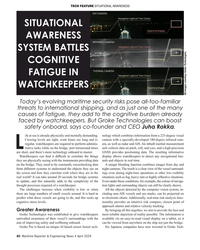 )
April 2024 - Maritime Reporter and Engineering News page: 40
)
April 2024 - Maritime Reporter and Engineering News page: 40, and as just one of the many causes of fatigue, they add to the cognitive burden already faced by watchkeepers. But Groke Technologies can boost safety onboard, says co-founder and CEO Juha Rokka. ife at sea is already physically and mentally demanding. nology which combines information from a 225-degree
-
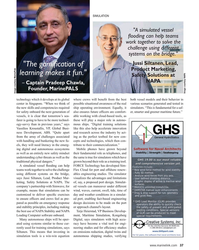 )
April 2024 - Maritime Reporter and Engineering News page: 37
)
April 2024 - Maritime Reporter and Engineering News page: 37solve the challenge using different systems on the bridge." – Jussi Siltanen, Lead, "The gami? cation of Product Marketing, learning makes it fun." Safety Solutions at NAPA – Captain Pradeep Chawla, Founder, MarinePALS Image courtesy MarinePals Image courtesy NAPA technology which it develops at its
-
 )
April 2024 - Maritime Reporter and Engineering News page: 35
)
April 2024 - Maritime Reporter and Engineering News page: 35in a variety of short weather and sea conditions, aiming to improve the advanced and entertaining ways. MarinePALS is therefore embracing a navigational safety skills required for CTV ship handling. new approach that involves interactive experiences and bite- Simulators are becoming as interconnected as onboard
-
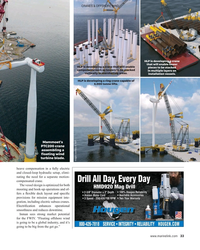 )
April 2024 - Maritime Reporter and Engineering News page: 33
)
April 2024 - Maritime Reporter and Engineering News page: 33CRANES & OFFSHORE WIND HLP is developing a crane that will enable tower HLP is developing a crane that will enable pieces to be stacked components such as towers to be stacked in multiple layers on vertically in marshalling areas. installation vessels. HLP is developing a ring crane capable of 6
-
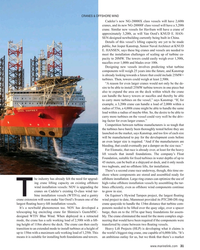 )
April 2024 - Maritime Reporter and Engineering News page: 31
)
April 2024 - Maritime Reporter and Engineering News page: 31CRANES & OFFSHORE WIND Cadeler’s new NG-20000X class vessels will have 2,600t cranes, and its new NG-20000F class vessel will have a 3,200t crane. Similar new vessels for Havfram will have a crane of approximately 3,200t, as will Van Oord’s KNUD E. HAN- SEN-designed newbuilding currently being built in
-
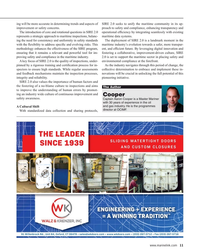 )
April 2024 - Maritime Reporter and Engineering News page: 11
)
April 2024 - Maritime Reporter and Engineering News page: 11ing will be more accurate in determining trends and aspects of SIRE 2.0 seeks to unify the maritime community in its ap- improvement or safety concerns. proach to safety and compliance, enhancing transparency and The introduction of core and rotational questions in SIRE 2.0 operational ef? ciency by
-
 )
April 2024 - Maritime Reporter and Engineering News page: 10
)
April 2024 - Maritime Reporter and Engineering News page: 10Maritime Safety © Roman/AdobeStock SIRE 2.0: Navigating the New Horizon of Maritime Safety By Captain Aaron Cooper, Programs Director, OCIMF he maritime industry is on the cusp of a signi? cant preparing vessel operators and vessel assurance teams for the transformation with the launch of the Ship
-
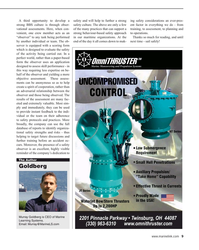 )
April 2024 - Maritime Reporter and Engineering News page: 9
)
April 2024 - Maritime Reporter and Engineering News page: 9A third opportunity to develop a safety and will help to further a strong ing safety considerations an ever-pres- strong BBS culture is through obser- safety culture. The above are only a few ent factor in everything we do - from vational assessments. Here, when con- of the many practices that can
-
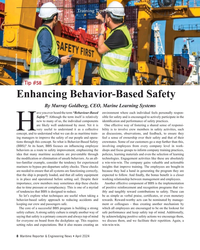 )
April 2024 - Maritime Reporter and Engineering News page: 8
)
April 2024 - Maritime Reporter and Engineering News page: 8Training Tips for Ships © By tuastockphoto/AdobeStock Tip #58 Enhancing Behavior-Based Safety By Murray Goldberg, CEO, Marine Learning Systems ave you ever heard the term “Behaviour-Based environment where each individual feels personally respon- Safety”? Although the term itself is relatively sible for
-
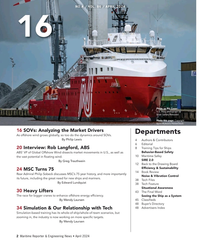 )
April 2024 - Maritime Reporter and Engineering News page: 2
)
April 2024 - Maritime Reporter and Engineering News page: 2the dynamics around SOVs. By Philip Lewis 4 Authors & Contributors 6 Editorial 8 Training Tips for Ships 20 Interview: Rob Langford, ABS Behavior-Based Safety ABS’ VP of Global Offshore Wind dissects market movements in U.S., as well as 10 Maritime Safey the vast potential in ? oating wind. SIRE 2.0 By
-
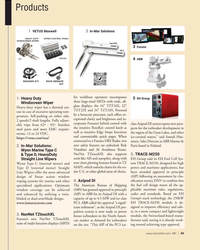 )
April 2024 - Marine News page: 43
)
April 2024 - Marine News page: 43. When ice-covered waters,” said Samuli Hän- https://vetus.com/usa/ connected to a Furuno DRS Radar, two ninen, Sales Director at ABB Marine & new safety features are unlocked: Risk Ports based in Finland. 2. In-Mar Solutions: Visualizer and AI Avoidance Route. Wynn Marine Type C NavNet TZtouchXL
-
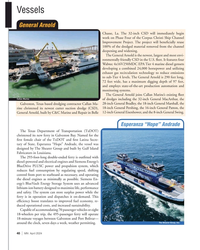 )
April 2024 - Marine News page: 40
)
April 2024 - Marine News page: 40minimally as possible. Siemens En- ergy’s BlueVault Energy Storage System uses an advanced lithium-ion battery designed to maximize life, performance and safety. The system can store surplus power while the ferry is in operation and dispatches it on-demand. This ef? ciency boost translates to improved fuel
-
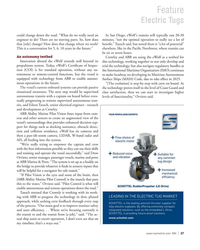 )
April 2024 - Marine News page: 37
)
April 2024 - Marine News page: 37to progress the technology in slow, phased approach, while seeking crew feedback through every step of the process. “Our main goal is to improve mariner safety and asset ef? ciency. . . Where we’re focusing currently is the transit to and the transit from [a job],” said. “The ac- tual ship assist or escort
-
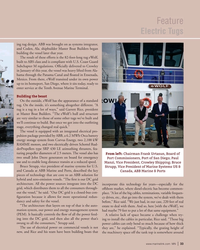 )
April 2024 - Marine News page: 33
)
April 2024 - Marine News page: 33, variable frequen- ? guration because it allows for more operational redun- cy drives, etc., that go into the system, we’ve dealt with them dancy and safety for the vessel. before,” Rice said. “We just had, in our case, 220 feet of real “The architecture that layers on top of that is the auto- estate to
-
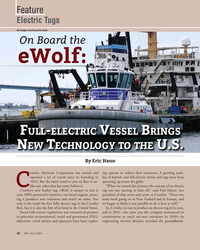 )
April 2024 - Marine News page: 32
)
April 2024 - Marine News page: 32Feature Electric Tugs All images courtesy Eric Haun On Board the eWolf: F - V B ULL ELECTRIC ESSEL RINGS EW ECHNOLOGY TO THE N T U.S. By Eric Haun rowley Maritime Corporation has owned and ing options to reduce their emissions. A growing num- operated a lot of vessels since its founding in ber
-
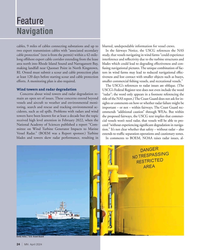 )
April 2024 - Marine News page: 24
)
April 2024 - Marine News page: 24“Com- ceed “without experiencing signi? cant degradation in naviga- mittee on Wind Turbine Generator Impacts to Marine tion.” It’s not clear whether that safety – without radar – also Vessel Radar.” (BOEM was a Report sponsor.) Turbine extends to traf? c separation operations and cautionary zones. blades
-
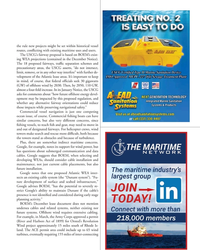 )
April 2024 - Marine News page: 23
)
April 2024 - Marine News page: 23may be impacted by this proposed regulation, and whether any alternative fairway orientations could reduce those impacts while preserving navigational safety.” Commercial vessel navigation is just one competing ocean issue, of course. Commercial ? shing boats can have similar concerns, but also very different
-
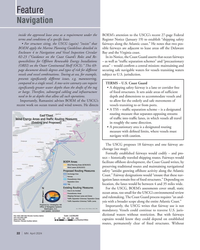 )
April 2024 - Marine News page: 22
)
April 2024 - Marine News page: 22the BOEM’s attention to the USCG’s recent 27-page Federal terms and conditions of a speci? c lease. Register Notice (January 19) to establish “shipping safety • For structure siting, the USCG (again) “insists” that fairways along the Atlantic coast.” He notes that two pos- BOEM apply the Marine Planning
-
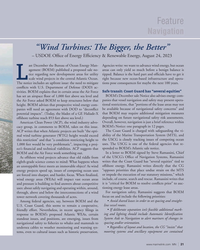 )
April 2024 - Marine News page: 21
)
April 2024 - Marine News page: 21set an airspace ? oor of 1,000 feet above sea level and the Air Force asked BOEM to keep structures below that panies that vessel navigation and safety may present opera- tional restrictions, that “portions of the lease areas may not height. BOEM advises that prospective wind energy com- panies will
